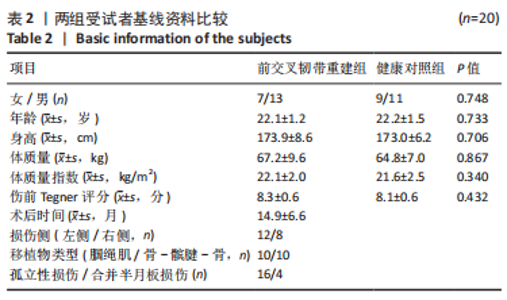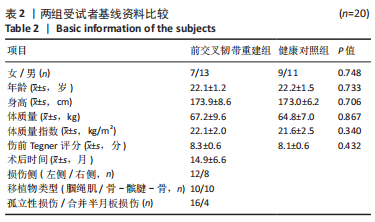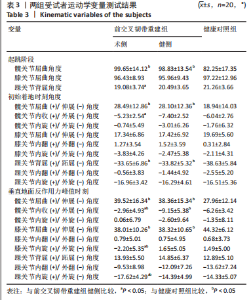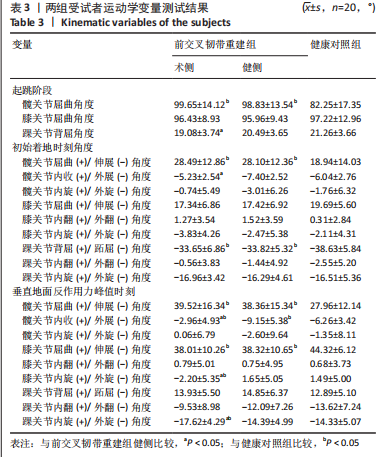Chinese Journal of Tissue Engineering Research ›› 2024, Vol. 28 ›› Issue (14): 2215-2220.doi: 10.12307/2024.357
Previous Articles Next Articles
Biomechanical characteristics of the lower limbs of athletes after anterior cruciate ligament reconstruction during bilateral vertical jumping
Wang Ling1, 2, Jiang Xia3, Chen Peng1, 2, Zheng Cheng3, Xu Jinrong4
- 1School of Sports Medicine, Wuhan Sports University, Wuhan 430079, Hubei Province, China; 2Key Laboratory of Sports Engineering of General Administration of Sport of China, Wuhan Sports University, Wuhan 430079, Hubei Province, China; 3Affiliated Hospital of Wuhan Sports University, Wuhan 430079, Hubei Province, China; 4Central China Normal University Hospital, Wuhan 430079, Hubei Province, China
-
Received:2023-04-28Accepted:2023-06-26Online:2024-05-18Published:2023-07-28 -
Contact:Xu Jinrong, Master, Associate chief physician, Central China Normal University Hospital, Wuhan 430079, Hubei Province, China -
About author:Wang Ling, Master candidate, School of Sports Medicine, Wuhan Sports University, Wuhan 430079, Hubei Province, China; Key Laboratory of Sports Engineering of General Administration of Sport of China, Wuhan Sports University, Wuhan 430079, Hubei Province, China -
Supported by:Donghu Scholar Program of Wuhan Sports University and Research Fund for Young Teachers of Wuhan Sports University, No. 20Z01 (to ZC)
CLC Number:
Cite this article
Wang Ling, Jiang Xia, Chen Peng, Zheng Cheng, Xu Jinrong. Biomechanical characteristics of the lower limbs of athletes after anterior cruciate ligament reconstruction during bilateral vertical jumping[J]. Chinese Journal of Tissue Engineering Research, 2024, 28(14): 2215-2220.
share this article
Add to citation manager EndNote|Reference Manager|ProCite|BibTeX|RefWorks
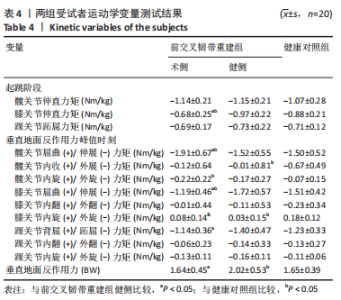
起跳阶段,与健康对照组相比,前交叉韧带重建组受试者术侧与健侧均显示出更高的髋关节屈曲角度(P=0.001,P=0.002)。与健侧相比,前交叉韧带重建组受试者术侧表现出更低的踝关节背屈角度(P=0.004)。 初始着地时刻,与健康对照组相比,前交叉韧带重建组受试者术侧与健侧均显示出更高的髋关节屈曲角度(P=0.031,P=0.035)、更低的踝关节跖屈角度(P=0.018,P=0.010)。与健侧相比,前交叉韧带重建组受试者术侧表现出更低的髋关节外展角度(P=0.008)。 垂直地面反作用力峰值时刻,与健康对照组相比,前交叉韧带重建组受试者术侧与健侧均表现出更高的髋关节屈曲角度(P=0.016,P=0.023)、更低的膝关节屈曲角度(P=0.025,P=0.037),术侧显示出更低的髋关节外展角度(P=0.019)及更高的膝关节外旋角度、踝关节外旋角度(P=0.030,P=0.042),健侧显示出更高的髋关节外展角度(P=0.049)。与健侧相比,前交叉韧带重建组受试者术侧表现出更低的髋关节外展角度(P=0.002),更高的膝关节内旋角度及踝关节外旋角度(P=0.017,P=0.004)。 2.5 两组受试者动力学变量测试结果 见表4。"


起跳阶段,与健康对照组和同组健侧相比,前交叉韧带重建组受试者术侧表现出更低的膝关节伸直力矩(P=0.009,P < 0.001)。 垂直地面反作用力峰值时刻,与健康对照组相比,前交叉韧带重建组受试者术侧与健侧均显示出更低的髋关节外展力矩(P=0.004,P=0.005)、更低的膝关节内旋力矩(P=0.016,P=0.001),术侧表现出更高的髋关节伸展力矩(P=0.040)、更高的髋关节外旋力矩(P=0.005)、更低的膝关节伸展力矩(P=0.036),健侧表现出更高的垂直地面反作用力(P=0.017)。与健侧相比,前交叉韧带重建组受试者术侧表现出更高的髋关节伸展力矩(P=0.003)及更低的膝关节伸展力矩(P < 0.001)、踝关节跖屈力矩(P=0.03)、垂直地面反作用力(P=0.005)。 2.6 不良事件 测试期间40名受试者未发生不良事件。"

| [1] SANDERS TL, MARADIT KREMERS H, BRYAN AJ, et al. Incidence of Anterior Cruciate Ligament Tears and Reconstruction: A 21-Year Population-Based Study. Am J Sports Med. 2016;44(6):1502-1507. [2] DANIEL DM, STONE ML, DOBSON BE, et al. Fate of the ACL-injured patient. A prospective outcome study. Am J Sports Med. 1994;22(5):632-644. [3] PASCHOS NK, HOWELL SM. Anterior cruciate ligament reconstruction: principles of treatment. EFORT Open Rev. 2016;1(11):398-408. [4] KIAPOUR AM, MURRAY MM. Basic science of anterior cruciate ligament injury and repair. Bone Joint Res. 2014;3(2):20-31. [5] ARDERN CL, TAYLOR NF, FELLER JA, et al. Fifty-five per cent return to competitive sport following anterior cruciate ligament reconstruction surgery: an updated systematic review and meta-analysis including aspects of physical functioning and contextual factors. Br J Sports Med. 2014;48(21):1543-1552. [6] WIGGINS AJ, GRANDHI RK, SCHNEIDER DK, et al. Risk of Secondary Injury in Younger Athletes After Anterior Cruciate Ligament Reconstruction: A Systematic Review and Meta-analysis. Am J Sports Med. 2016;44(7):1861-1876. [7] HARRIS JD, ABRAMS GD, BACH BR, et al. Return to sport after ACL reconstruction. Orthopedics. 2014;37(2):e103-108. [8] BURGI CR, PETERS S, ARDERN CL, et al. Which criteria are used to clear patients to return to sport after primary ACL reconstruction? A scoping review. Br J Sports Med. 2019;53(18):1154-1161. [9] BARBER-WESTIN SD, NOYES FR. Factors used to determine return to unrestricted sports activities after anterior cruciate ligament reconstruction. Arthroscopy. 2011;27(12):1697-1705. [10] BARBER-WESTIN SD, NOYES FR. Objective criteria for return to athletics after anterior cruciate ligament reconstruction and subsequent reinjury rates: a systematic review. Phys Sportsmed. 2011;39(3):100-110. [11] KYRITSIS P, BAHR R, LANDREAU P, et al. Likelihood of ACL graft rupture: not meeting six clinical discharge criteria before return to sport is associated with a four times greater risk of rupture. Br J Sports Med. 2016;50(15):946-951. [12] VAN MELICK N, VAN CINGEL RE, BROOIJMANS F, et al. Evidence-based clinical practice update: practice guidelines for anterior cruciate ligament rehabilitation based on a systematic review and multidisciplinary consensus. Br J Sports Med. 2016;50(24):1506-1515. [13] PATERNO MV, SCHMITT LC, FORD KR, et al. Biomechanical measures during landing and postural stability predict second anterior cruciate ligament injury after anterior cruciate ligament reconstruction and return to sport. Am J Sports Med. 2010;38(10):1968-1978. [14] HEWETT TE, MYER GD, FORD KR, et al. Biomechanical measures of neuromuscular control and valgus loading of the knee predict anterior cruciate ligament injury risk in female athletes: a prospective study. Am J Sports Med. 2005;33(4):492-501. [15] ABRAMS GD, HARRIS JD, GUPTA AK, et al. Functional Performance Testing After Anterior Cruciate Ligament Reconstruction: A Systematic Review. Orthop J Sports Med. 2014;2(1):2325967113518305. [16] SCHMITT LC, PATERNO MV, FORD KR, et al. Strength Asymmetry and Landing Mechanics at Return to Sport after Anterior Cruciate Ligament Reconstruction. Med Sci Sports Exerc. 2015;47(7):1426-1434. [17] DAVEY MS, HURLEY ET, WITHERS D, et al. Anterior Cruciate Ligament Reconstruction with Platelet-Rich Plasma: A Systematic Review of Randomized Control Trials. Arthroscopy. 2020;36(4):1204-1210. [18] 姚军威,韦俏丽,马勇,等.基于Anybody的足球运动员大角度侧切下肢生物力学仿真分析[J].中国运动医学杂志,2022,41(1):9-16. [19] KOTSIFAKI A, VAN ROSSOM S, WHITELEY R, et al. Single leg vertical jump performance identifies knee function deficits at return to sport after ACL reconstruction in male athletes. Br J Sports Med. 2022;56(9):490-498. [20] KRISTIANSLUND E, KROSSHAUG T, VAN DEN BOGERT AJ. Effect of low pass filtering on joint moments from inverse dynamics: implications for injury prevention. J Biomech. 2012;45(4):666-671. [21] POZZI F, DI STASI S, ZENI JA JR, et al. Single-limb drop landing biomechanics in active individuals with and without a history of anterior cruciate ligament reconstruction: A total support analysis. Clin Biomech (Bristol, Avon). 2017;43: 28-33. [22] KOTSIFAKI A, WHITELEY R, VAN ROSSOM S, et al. Single leg hop for distance symmetry masks lower limb biomechanics: time to discuss hop distance as decision criterion for return to sport after ACL reconstruction?. Br J Sports Med. 2022;56(5):249-256. [23] WREN TAL, MUESKE NM, BROPHY CH, et al. Hop Distance Symmetry Does Not Indicate Normal Landing Biomechanics in Adolescent Athletes With Recent Anterior Cruciate Ligament Reconstruction. J Orthop Sports Phys Ther. 2018;48(8): 622-629. [24] MACKALA K, STODóŁKA J, SIEMIENSKI A, et al. Biomechanical analysis of standing long jump from varying starting positions. J Strength Cond Res. 2013;27(10): 2674-2684. [25] KOTSIFAKI A, VAN ROSSOM S, WHITELEY R, et al. Symmetry in Triple Hop Distance Hides Asymmetries in Knee Function After ACL Reconstruction in Athletes at Return to Sports. Am J Sports Med. 2022;50(2):441-450. [26] 陈鹏,王玲,董诗雨,等.全身振动训练对前交叉韧带重建后影响的Meta分析[J].中国组织工程研究,2023,27(36):5875-5883. [27] POLLARD CD, SIGWARD SM, POWERS CM. Limited hip and knee flexion during landing is associated with increased frontal plane knee motion and moments. Clin Biomech (Bristol, Avon). 2010;25(2):142-146. [28] ELVIN NG, ELVIN AA, ARNOCZKY SP, et al. The correlation of segment accelerations and impact forces with knee angle in jump landing. J Appl Biomech. 2007;23(3): 203-212. [29] WARD SH, BLACKBURN JT, PADUA DA, et al. Quadriceps Neuromuscular Function and Jump-Landing Sagittal-Plane Knee Biomechanics After Anterior Cruciate Ligament Reconstruction. J Athl Train. 2018;53(2):135-143. [30] KOTSIFAKI A, KORAKAKIS V, WHITELEY R, et al. Measuring only hop distance during single leg hop testing is insufficient to detect deficits in knee function after ACL reconstruction: a systematic review and meta-analysis. Br J Sports Med. 2020;54(3):139-153. [31] LEE J, SONG Y, SHIN CS. Effect of the sagittal ankle angle at initial contact on energy dissipation in the lower extremity joints during a single-leg landing. Gait Posture. 2018;62:99-104. [32] STANLEY LE, HARKEY M, LUC-HARKEY B, et al. Ankle Dorsiflexion displacement is associated with hip and knee kinematics in females following anterior cruciate ligament reconstruction. Res Sports Med. 2019;27(1):21-33. [33] KHAYAMBASHI K, GHODDOSI N, STRAUB RK, et al. Hip Muscle Strength Predicts Noncontact Anterior Cruciate Ligament Injury in Male and Female Athletes: A Prospective Study. Am J Sports Med. 2016;44(2):355-361. [34] ENGELEN-VAN MELICK N, VAN CINGEL REH, VAN TIENEN TG, et al. Functional performance 2-9 years after ACL reconstruction: cross-sectional comparison between athletes with bone-patellar tendon-bone, semitendinosus/gracilis and healthy controls. Knee Surg Sports Traumatol Arthrosc. 2017;25(5):1412-1423. [35] HOFBAUER M, THORHAUER ED, ABEBE E, et al. Altered tibiofemoral kinematics in the affected knee and compensatory changes in the contralateral knee after anterior cruciate ligament reconstruction. Am J Sports Med. 2014;42(11):2715-2721. [36] MEYER CAG, GETTE P, MOUTON C, et al. Side-to-side asymmetries in landing mechanics from a drop vertical jump test are not related to asymmetries in knee joint laxity following anterior cruciate ligament reconstruction. Knee Surg Sports Traumatol Arthrosc. 2018;26(2):381-390. [37] MUESKE NM, PATEL AR, PACE JL, et al. Improvements in landing biomechanics following anterior cruciate ligament reconstruction in adolescent athletes. Sports Biomech. 2020;19(6):738-749. [38] OIESTAD BE, HOLM I, AUNE AK, et al. Knee function and prevalence of knee osteoarthritis after anterior cruciate ligament reconstruction: a prospective study with 10 to 15 years of follow-up. Am J Sports Med. 2010;38(11):2201-2210. [39] SRITHARAN P, MUñOZ MA, PIVONKA P, et al. Biomechanical Markers of Forward Hop-Landing After ACL-Reconstruction: A Pattern Recognition Approach. Ann Biomed Eng. 2022;50(3):330-342. [40] READ PJ, OLIVER JL, DE STE CROIX MBA, et al. A prospective investigation to evaluate risk factors for lower extremity injury risk in male youth soccer players. Scand J Med Sci Sports. 2018;28(3):1244-1251. [41] PATERNO MV, SCHMITT LC, FORD KR, et al. Effects of sex on compensatory landing strategies upon return to sport after anterior cruciate ligament reconstruction. J Orthop Sports Phys Ther. 2011;41(8):553-559. [42] BELL DR, KULOW SM, STIFFLER MR, et al. Squatting mechanics in people with and without anterior cruciate ligament reconstruction: the influence of graft type. Am J Sports Med. 2014;42(12):2979-2987. [43] TAN SHS, LAU BPH, KRISHNA L. Outcomes of Anterior Cruciate Ligament Reconstruction in Females Using Patellar-Tendon-Bone versus Hamstring Autografts: A Systematic Review and Meta-Analysis. J Knee Surg. 2019;32(8):770-787. [44] HEWETT TE, MYER GD, FORD KR. Anterior cruciate ligament injuries in female athletes: Part 1, mechanisms and risk factors. Am J Sports Med. 2006;34(2):299-311. |
| [1] | Wang Juan, Wang Guanglan, Zuo Huiwu. Efficacy of exercise therapy in the treatment of anterior cruciate ligament reconstruction patients: #br# a network meta-analysis #br# [J]. Chinese Journal of Tissue Engineering Research, 2025, 29(8): 1714-1726. |
| [2] | Lu Jieming, Li Yajing, Du Peijie, Xu Dongqing. Effects of artificial turf versus natural grass on biomechanical performance of the lower limbs in young females during jump-landing [J]. Chinese Journal of Tissue Engineering Research, 2025, 29(6): 1101-1107. |
| [3] | Wang X, Wang Hm, Chen Sh, Feng Tx, Bu Hm, Zhu Lg, Chen Dd, Wei X. Stress and morphological characteristics of intervertebral foramen of cervical rotation-traction manipulation for treating cervical spondylotic radiculopathy: a three-dimensional finite element analysis [J]. Chinese Journal of Tissue Engineering Research, 2025, 29(3): 441-447. |
| [4] | Zhao Yuxin, Liang Liang, Jin Feng, Xu Yangyang, Kang Zhijie, Fang Yuan, He Yujie, Wang Xing, Wang Haiyan, Li Xiaohe. Establishment and stress analysis of a finite element model for adolescent cervical disc herniation [J]. Chinese Journal of Tissue Engineering Research, 2025, 29(3): 448-454. |
| [5] | Li Zhenggang, Shang Xuehong, Wu Zhang, Li Hong, Sun Chaojun, Chen Huadong, Sun Zhe, Yang Yi. Finite element analysis of three internal fixation modalities for treatment of Pauwels type III femoral neck fractures under different loading conditions [J]. Chinese Journal of Tissue Engineering Research, 2025, 29(3): 455-463. |
| [6] | Liu Mengfei, Chen Gang, Shi Yihan, Zeng Lin, Jiang Kan, Yilihamujiang•Wusiman. Finite element analysis of optimization of femoral prosthesis implantation position in unicompartmental knee arthroplasty in osteoporotic patients [J]. Chinese Journal of Tissue Engineering Research, 2025, 29(3): 464-470. |
| [7] | Wang Zilong, Meng Xin, Zhang Zhiqi, Xie Yu, Meng Lingyue, Zhang Qiuxia, Kong Lingyu. Biomechanical characteristics of lower extremities during counter movement jump in male patients with functional ankle instability [J]. Chinese Journal of Tissue Engineering Research, 2025, 29(3): 478-485. |
| [8] | Liang Jiyao, Zhou Honghai, Wei Guikang, Su Shaoting, Chen Longhao, He Xinyu, Liu Liangpu. Quantification of in vivo biomechanics and analysis of influencing factors in cervical spine fixed-point rotation manipulation [J]. Chinese Journal of Tissue Engineering Research, 2025, 29(3): 486-492. |
| [9] | Su Dejun, Dong Wanpeng, Dong Yuefu, Zhang Jichao, Zhang Zhen. Design of asymmetric prosthesis and mechanical analysis of total knee arthroplasty [J]. Chinese Journal of Tissue Engineering Research, 2025, 29(3): 510-516. |
| [10] | He Kai, Xing Wenhua, Liu Shengxiang, Bai Xianming, Zhou Chen, Gao Xu, Qiao Yu, He Qiang, Gao Zhiyu, Guo Zhen, Bao Aruhan, Li Chade. Constructing a model of degenerative scoliosis using finite element method: biomechanical analysis in etiology and treatment [J]. Chinese Journal of Tissue Engineering Research, 2025, 29(3): 572-578. |
| [11] | Gao Xilin, Wu Si Zhang Chao Zhu Liguo, Fu Bifeng, Wang Ping. Mechanotransduction proteins in intervertebral disc degeneration [J]. Chinese Journal of Tissue Engineering Research, 2025, 29(3): 579-589. |
| [12] | Bai Chen, Yang Wenqian, Meng Zhichao, Wang Yuze. Strategies for repairing injured anterior cruciate ligament and promoting graft healing [J]. Chinese Journal of Tissue Engineering Research, 2024, 28(9): 1457-1463. |
| [13] | Li Zhifei, Yang Yin, Chen Hualong, Liang Qinqiu, Zhong Yuanming, Zhang Yisheng. Finite element analysis of the correlation between tilt angle of titanium cage and postoperative subsidence of titanium cage after anterior subtotal cervical corpectomy, decompression and fusion [J]. Chinese Journal of Tissue Engineering Research, 2024, 28(9): 1313-1319. |
| [14] | Chen Mengmeng, Bao Li, Chen Hao, Jia Pu, Feng Fei, Shi Guan, Tang Hai. Biomechanical characteristics of a novel interspinous distraction fusion device BacFuse for the repair of lumbar degenerative disease [J]. Chinese Journal of Tissue Engineering Research, 2024, 28(9): 1325-1329. |
| [15] | Liang Cheng, Zhang Linqi, Wang Guan, Li Wen, Duan Ke, Li Zhong, Lu Xiaobo, Zhuo Naiqiang. Finite element and biomechanical analysis of different implants in repair for unilateral unstable pelvic posterior ring injury [J]. Chinese Journal of Tissue Engineering Research, 2024, 28(9): 1336-1341. |
| Viewed | ||||||
|
Full text |
|
|||||
|
Abstract |
|
|||||


